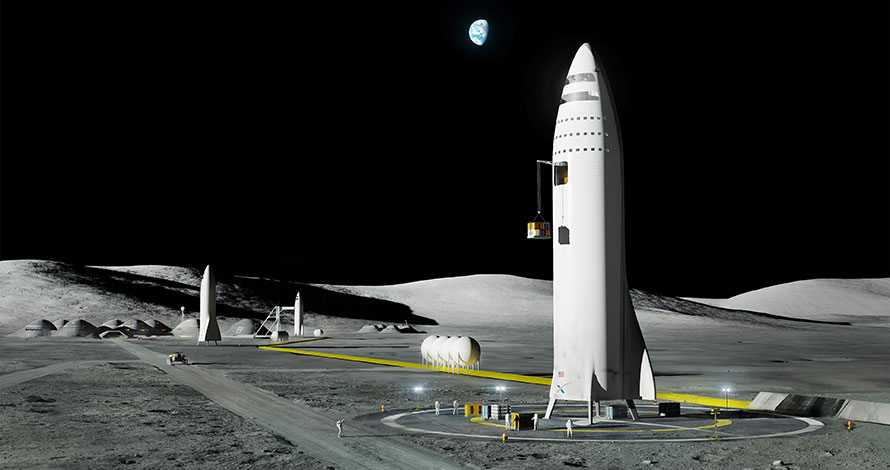
Image: SpaceX
- Roadmap Table of Contents
- Part 1: General Milestones
- Part 2: Utilization and Development of Cislunar Space
- Part 3: To the Moon (this page)
- Part 4: To Mars
- Part 5: Asteroid Mining and Orbital Space Settlements
- Part 6: Additional Expansion and Greater Sustainability of Human Civilization
The Moon, only a quarter of a million miles away and passing overhead every night, beckons as a visible and obvious destination for human settlement.
PARTICULAR BARRIERS:
Major Barriers specific to settlement of the Moon will have to be overcome to reach the Milestones en route to that settlement. Those Barriers include:
Psychological and Political Commitment. Until successive phases of lunar exploration have shown a likelihood of affordability and sustainability, no country, private entity, or group is likely to make a firm commitment to a permanent human settlement on the Moon. So far there is no such commitment.
Goal Definition. There is a lack of consensus on a clear set of lunar goals that would move beyond flags and footprints.
Architecture Definition. There is a lack of information and consensus on the infrastructure needed and the order in which it should be built.
Economics. Supporting human lunar operations will be expensive. There is no agreement on how to financially support them.
Biological. There are two major potential barriers to a permanent human settlement on the Moon: radiation, and gravity only one-sixth that of Earth.
(1) Lethal ionizing radiation comes from the Sun and even more powerful cosmic rays originate from outside the solar system. Habitats will have to be shielded, probably by being covered with thick layers of local regolith or by being built underground. More difficult will be finding a way to shield humans while operating on the surface.
(2) Gravity is the true unknown. Humans (as well as other animals and plants) are the product of some 500 million years of terrestrial evolution, all that time being adapted to live in a one-gravity environment. We already know of problems from long duration space flight, such as bone loss and vision degradation. No one knows whether or not humans can live long-term in the low lunar gravity, nor whether offspring can be safely born and raised.
Certain Lunar Characteristics. Each body orbiting the Sun has its own characteristics. The Moon presents some unique challenges which will have to be overcome – e.g., its half-month days followed by half-month nights creating a 500 degree temperature swing in most areas, its pervasive and abrasive dust, its lack of easily recoverable water except in probable ice deposits close to the poles, and the unknown usability of those deposits.
MILESTONE 18. Robotic Confirmation of Lunar Resources
Orbiters and robotic landers to determine the nature and extent of lunar ice, volatile deposits and other lunar resources, and to provide the information necessary to guide the choice of the best sites for a lunar outpost and/or a lunar mining base.
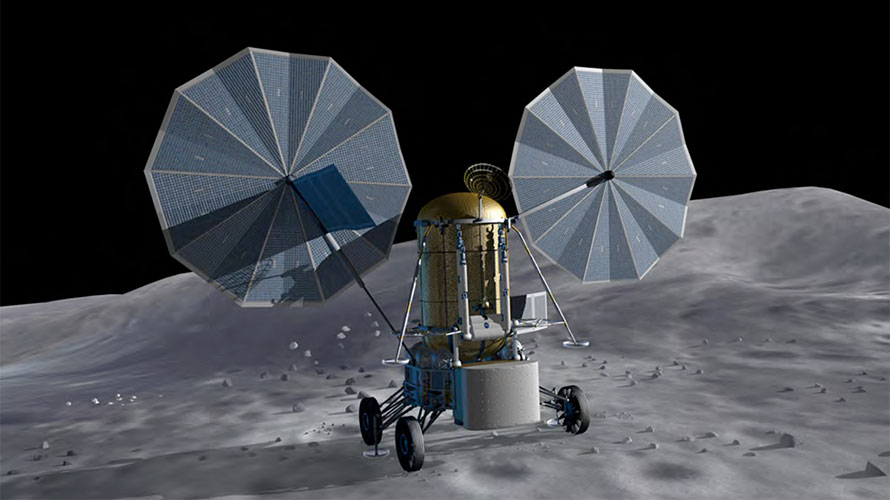 ISRU water processing demo. Image: NASA
ISRU water processing demo. Image: NASA
DESCRIPTION
The Apollo missions chose landing sites primarily on the basis of safety on landing and then on the basis of general scientific interest to learn about the history and composition of the Moon. Future lunar robotic missions should emphasize discovering what lunar resources can best be utilized for human benefit. Sites for future lunar outposts and bases will probably be determined by the findings of those robotic missions.
Water and Lunar Volatiles. Robotic probes from several countries have determined that water and other valuable volatile elements are present in significant percentages in lunar soil in four volatile deposit zones (near the current and previous lunar pole locations), notably in deep, permanently shadowed craters. The pole positions were probably shifted by an asteroid collision at some time in the past, and the previous polar locations are a few degrees away from the current ones. We need to know what volatiles are present at each location, and how extensive and deeply buried they are. Knowing the proportion of the deposits consisting of water ice will be crucial to understanding their availability to make rocket fuel and breathing oxygen and to provide other support for human habitation. Every kilogram of water that does not need to be imported from Earth or other locations represents a significant step toward self-sufficiency and immensely eases the logistical requirements for supporting humans on the Moon. Thus, this knowledge about lunar volatiles will provide the basis for designing all subsequent lunar habitats.
Non-Volatile Resources. Other major resources on the Moon include oxygen, silicon, titanium, iron, magnesium, aluminum and calcium. Most of these resources are mixed into the regolith. Concentrations change significantly from highland to mare sites, but these minerals can be found essentially at any location on the Moon.
BARRIER
Delay/lack of commitment for lunar orbiter and rover missions which could characterize and verify the location, depth, thickness and concentration level of ice, volatile deposits, and other resources.
COMPLETION
This milestone can be considered achieved when enough data, including the locations of water deposits and other resources, have been gathered to intelligently pick one or more lunar sites for outposts and/or bases.
MILESTONE 19. A Lunar Research and Development Facility
A crewed lunar research facility established to study human habitation, test various equipment and techniques, test mining of lunar resources, and conduct lunar science investigations.
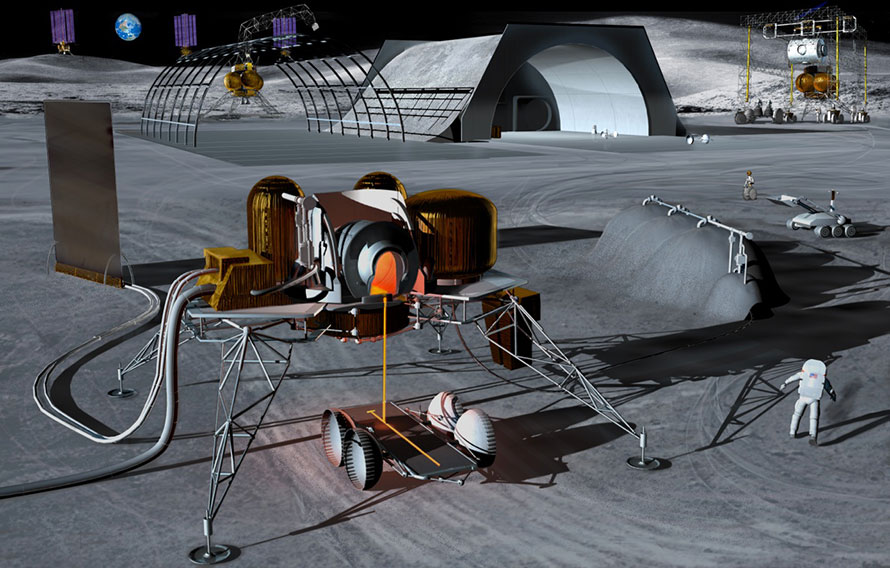 ISRU Lunar Base. Artwork: Mark Maxwell courtesy Dennis Wingo and Skycorp Inc.
ISRU Lunar Base. Artwork: Mark Maxwell courtesy Dennis Wingo and Skycorp Inc.
DESCRIPTION
A choice will be made for where to site the first lunar outpost. Habitation structures will be landed or built at the site for use during more than a single visit.
(A) Finding, selecting and validating sites for lunar outposts. Some of the most critical site characteristics may be detected by orbiters and by surface rovers. Various lunar sites should be considered for early outposts, each with advantages and disadvantages. Lunar polar sites have the advantage of less extreme temperature fluctuations, and do not have two-week long night periods. They also probably have valuable resources in deep craters in the four volatile deposit zones that are directly around and adjacent to the polar zones. Other site characteristics would be included in the selection process, such as: (1) mineral abundance levels in the regolith, (2) special geological features like lava tubes, (3) the nearby availability of sunlight (4), proximity to good locations for radio astronomy, (5) terrain roughness which affects the ability of rovers and humans to navigate around and use the site, (6) limitations to equipment use due to extremely low temperatures in permanently shadowed zones.
- Polar sites in general have areas with about 20% more sunlight (for power) than non-polar sites, with some small areas having up to 80% sunlight. The total lack of sunlight for solar power in shadowed polar areas is compensated by the fact that areas with more continuous sunlight access are nearby.
- There are slightly higher risks in landing inside a crater near a shadowed crater wall, or on a narrow crater rim of a fully shadowed crater.
- There would be difficulties in communication with Earth when a base is not in line of sight. Establishing a network of lunar relay satellites will ease that problem but will add to the infrastructure cost and complexity.
Lunar base sites outside the polar areas may be established later, or sooner if the polar volatiles prove to be difficult to extract, which may motivate a continued search for sites that may lack volatiles but might have advantages for a first outpost that a polar site lacks. All sites outside the immediate polar zones have a two week long lunar night, which makes additional reliable power sources mandatory.
(B) Facility design and operation. The first outpost should be designed to support successive missions, each building on the knowledge gained and infrastructure built by its predecessors. This facility may be government sponsored and funded, or could be established by private enterprises. The outpost may consist of a single module visited and used over and over or of multiple modules landed or constructed in later missions; the latter is likely to be the most cost-effective and productive. An early module could be a habitation module, allowing extended crew stays. Power supply modules must be landed before human crews arrive. Other deliveries, either before or after a habitation module, could be rovers, excavators, tractors, unloading and building equipment, pilot scale mining and smelting equipment, kilns for metallurgy, telescopes for astronomy, medical labs and other scientific modules, and more habitation modules. This staging would allow for both short visits by scientific specialists and the gradual building of a larger facility at the initial site.
The initial outpost could be either vacated between missions or continuously occupied with a small, rotating crew. If the latter, the outpost will be exceptionally useful in determining the ability of Earth life to thrive for long periods in the one-sixth gravity environment, and in the case of plants and other animals, to reproduce and complete life cycles successfully.
This first outpost will probably be a combined research facility and mining base, and probably at a polar location. The crew habitat module must be shielded from space radiation and temperature extremes. This can be done by burying the habitat underground or covering it with several meters of regolith. If sufficient equipment is available, and a large lunar lava tube is found in the right location, the tube might be used for shelter. Over time and as it grows, the outpost may be able to test, among other things:
- life support and recycling systems,
- effective means of keeping abrasive lunar dust out of the habitation modules.
- health maintenance regimens for the low gravity environment,
- cooking in one-sixth gravity,
- spacesuits,
- lunar transportation vehicles,
- alternate power sources and backup power supply systems (e.g., battery, solar, nuclear),
- if volatiles are found nearby, techniques for extracting water for direct use and rocket fuel synthesis
- construction and fabrication techniques using local materials
- creating a storage site for rocket fuel at a distance from the habitat,
- various methods and materials for providing radiation shielding,
- pilot scale, then later full scale mining and smelting techniques,
- manufacturing and fabrication techniques unique to one-sixth gravity and/or vacuum,
- crew psychology in a new environment,
- indoor plant growth for food production,
- animal life cycle tests with small mammals in the low gravity lunar environment.
A high priority will be placed on testing pilot scale production of water and rocket fuel from the polar deposits. If prototype equipment is delivered early in the program, the pilot scale can transition to full scale production sooner.
Surface explorations based from the facility will continue contributing to our scientific knowledge about the Moon. In addition, if the public relation possibilities are maximized, regular broadcasts from the Moon will serve to educate the public and increase support for further human space activities. Entertainment companies, in particular, may find a way to finance and profit from such activities.
The first outpost or outposts are likely to conform to current astronaut safety standards. That will mean (1) always having available a means for emergency evacuation to Earth or another safe crew refuge, and (2) having a shielded crew refuge which can sustain the crew against sudden burst of solar or cosmic radiation for a specified length of time (and which can also serve as a crew habitat during later normal operations). Apollo-mission level risks will probably not be accepted where long duration stays and routine lunar flight operations are involved.
COMPLETION
This milestone can be considered achieved when significant scientific results are returned and (depending on the amounts of volatile deposits found) when a commercially significant amount of lunar water has been extracted and processed.
MILESTONE 20. A Continuously Occupied Multi-Purpose Lunar Base
An initial lunar facility evolving into a permanently occupied, ever-expanding lunar base (or such a base created at another site), using what has been learned from the initial research and development facility, and increasingly performing commercial functions such as production of rocket fuel from volatile deposits and shipment of the fuel to orbit.
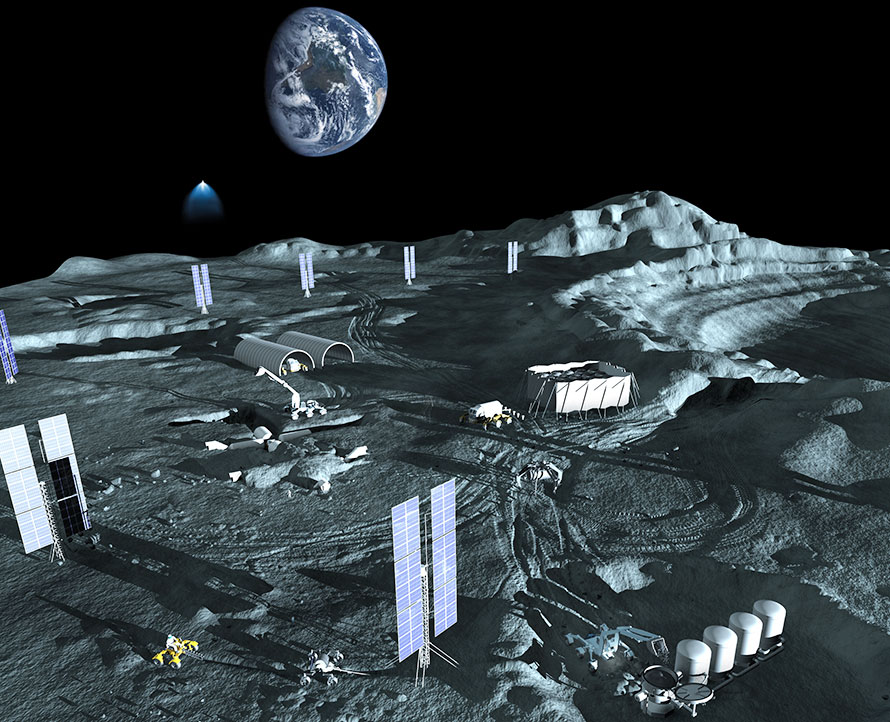
Lunar polar mining base with buried crew habitats, widely spaced solar power panels, propellant production plant and depot tank farm. Image: [email protected]
DESCRIPTION
Advancement of lunar (and Earth) science, use of resources, and preparation for possible future lunar settlements are some of the main rationales for a lunar base. The goals of science with In-Situ Resource Utilization (ISRU) may be paired to share the cost of the base. Both activities can also be conducted with a rotating crew, avoiding the possible long-term problems associated with low gravity, etc.
Early lunar bases run the risk of being abandoned if affordable space transportation systems are not used from the beginning and if the order and composition of critical base infrastructure is not agreed on. The risk of abandonment of an early lunar base may be lessened to the extent that, from the start, mission architectures are designed as a sustainable, modular, reusable and thus affordable, integrated system that pursues ISRU and self-sufficiency technologies as a very early goal. Creating an economic rationale for the base, such as a commercial ISRU operation that produces propellant for both lunar, cislunar and Mars operations, would greatly enhance the probability that the lunar base would continue to be supported.
Once the initial lessons have been learned from the lunar research and development facility, a growing lunar base will turn its attention to maximizing its usefulness to other space operations and achieving some commercial viability. The base will encourage early industry investment and involvement. Some separate modules could be privately financed, as could visits by various researchers.
Noncommercial Functions. The lunar base will continue the basic scientific and technological research begun by the research facility, possibly with government funding and direction, including Earth observation. The techniques learned during the Research Facility phase — e.g. utilization of lunar volatiles to produce rocket fuel — will increasingly be incorporated into the Base phase.
In addition, with the experience gained from operating in the lunar environment, the base may be used as a test-bed for developing and/or checking out the many technologies and hardware that will be needed for Mars. While Mars has a slight atmosphere, seasons, very different kinds of dust, and gravity twice that of the Moon (although still only about one-third that of Earth), conditions on the Moon provide a much more rigorous environment for thorough testing. Even entire modules intended for Mars could be field-tested on the Moon. It is a good test site, since the Moon is close enough to Earth for easier and faster resupply, and any rescue operations would be much faster than for Mars.
Commercial Functions. Commercial uses of the lunar base will gradually increase. As the technology improves and the risk from innovation uncertainty is substantially reduced, risks and potential profits of investment in the lunar infrastructure can be better evaluated. At that point, it is likely that investments in lunar enterprises will be more substantial. Possible commercial opportunities include, e.g:
- if the base is located near extractable volatiles, providing rocket propellant for cislunar and Mars operations could be one of the base’s primary and most commercially valuable uses,
- generation and sale of research data,
- production and sale of lunar entertainment media for Earth,
- tourism, with a bare-bones hotel module near the base with lunar excursions.
BARRIERS
- Lack of proof of commercially valuable volatile and mineral deposits on the Moon.
- Difficulty coping with lunar dust.
- Lack of agreement on radiation shielding levels, methods and technology, including whether the base will be above ground and covered by regolith, dug into ground, or in a lavatube.
- Continuing funding conflicts between multiple, seemingly divergent government space goals.
COMPLETION
This milestone can be considered to be achieved when the multi-purpose base has been continuously occupied for at least a decade or when a true lunar settlement is established.
MILESTONE 21. A True Lunar Settlement
A lunar base or other lunar habitations evolving into a permanent settlement, increasingly self-sufficient and increasingly focused on commercial activities.
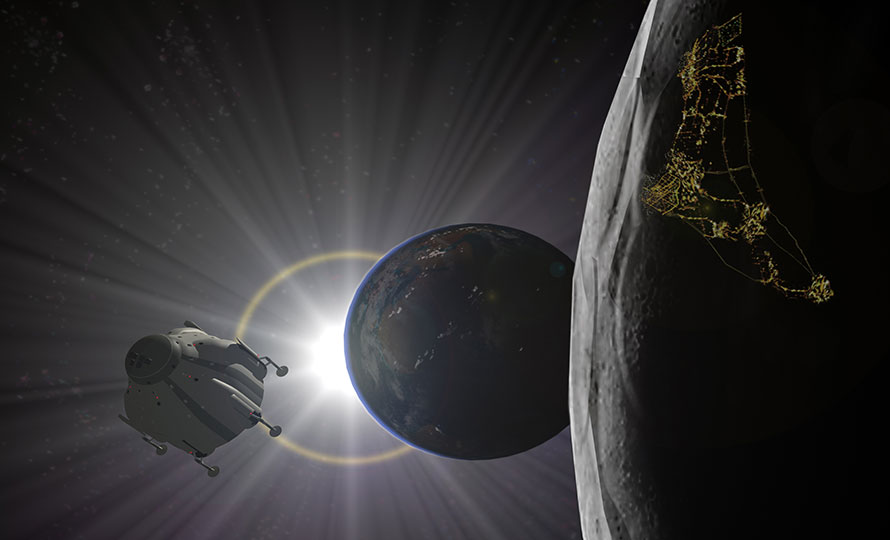 “Lunar Lights.” Image: Raymond Cassel
“Lunar Lights.” Image: Raymond Cassel
DESCRIPTION
As lunar habitation grows, in volume, in area, in the number of modules connected and nearby, and, especially, in population, at some point people will look back and realize that people are on the Moon for good. While it is hard to define a “permanent settlement,” some aspects that might be present include:
- people moving to the Moon with no intention of ever returning to Earth,
- residents other than employees,
- children being brought to the Moon and, gravity and other conditions permitting, being born and raised there,
- commercial businesses including manufacturing and markets
- schools and chapels / religious / gathering spaces,
- no requirement that enough vehicles be standing by to evacuate the entire population at once (though there would be provisions for evacuating people from individual modules in the event of emergency),
- surgical and medical facilities,
- Closed or Controlled Ecological Life Support Systems (CELSS) that recycle sufficiently to minimize the amount of imports needed for daily living (including food),
- some form of local governance,
- ability to make most repairs using local materials,
- facilities for visitors, whether scientists, tourists, or others,
- use as a staging point and support facility for the development of other lunar settlements.
While the settlement’s facilities are reasonably predictable, the composition of its population is not. That will depend on the biological effects of living in the low lunar gravity for long periods, even a lifetime, and on fetal development and later growth. It may be that people and their families will be able to move to the Moon and live there for generations, or it may be that the permanent settlement is filled by a constantly changing population.
As the cost of space transportation drops and the cost of the settlement is amortized or written off, the incipient commercial activities that were initiated in the base phase will be expanded. This includes tourism, development of products and services for use at other locations and for production of components to support services for Earth such as space solar power. Lunar hotels may be the most frequently added businesses. The low lunar gravity might even make the Moon a retirement destination of choice. An increasing proportion of lunar settlers will be involved in these commercial activities, rather than in routine maintenance.
One significant commercial activity that could be sustained by a growing lunar settlement would be the creation of a system of electromagnetic mass drivers or coil guns (similar to rail guns). These would precisely hurl mined lunar materials or lunar-derived rocket fuel directly from the airless lunar surface into trajectories where they would be captured in space. They could then be used to construct orbital space habitats or to refuel outbound spacecraft substantially more economically than could be done if those resources needed to be brought up from the bottom of Earth’s gravity well or from the lunar surface by rocket power.
Another activity that could be supported by a growing settlement would be the establishment and maintenance of permanent observatories at various locations, including on the far side of the Moon for radio astronomy, and on the near side of the Moon for continuous surveillance of cislunar space and the Earth.
BARRIERS
- Lack of volatiles on the Moon except at the poles.
- Lack of light elements and metals.
- Lack of concentrated metallic ore bodies.
- Cost of importing volatiles to non-polar lunar locations.
- Lack of consensus on economic models for early lunar commerce
- Lack of proof that humans can complete a normal life cycle in a 1/6 G environment and the impracticality of creating sufficiently high artificial gravity on the lunar surface.
COMPLETION
This milestone can be considered to be achieved when the lunar settlement has been occupied for several decades, with a long term population that is not declining.






